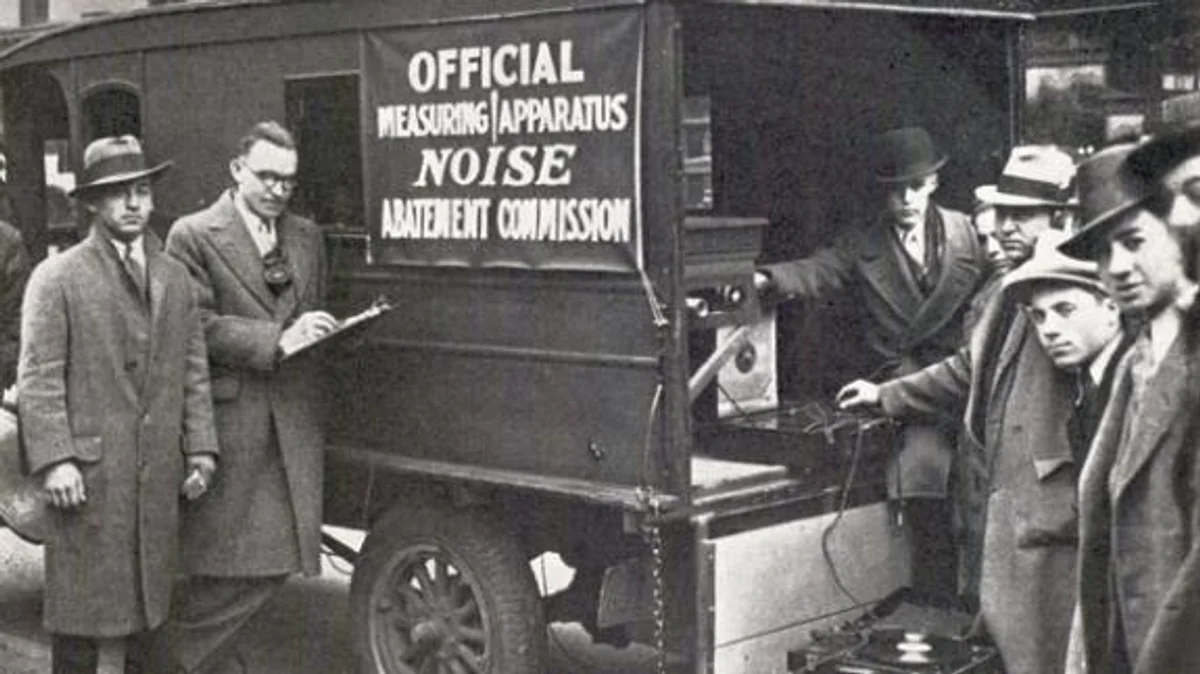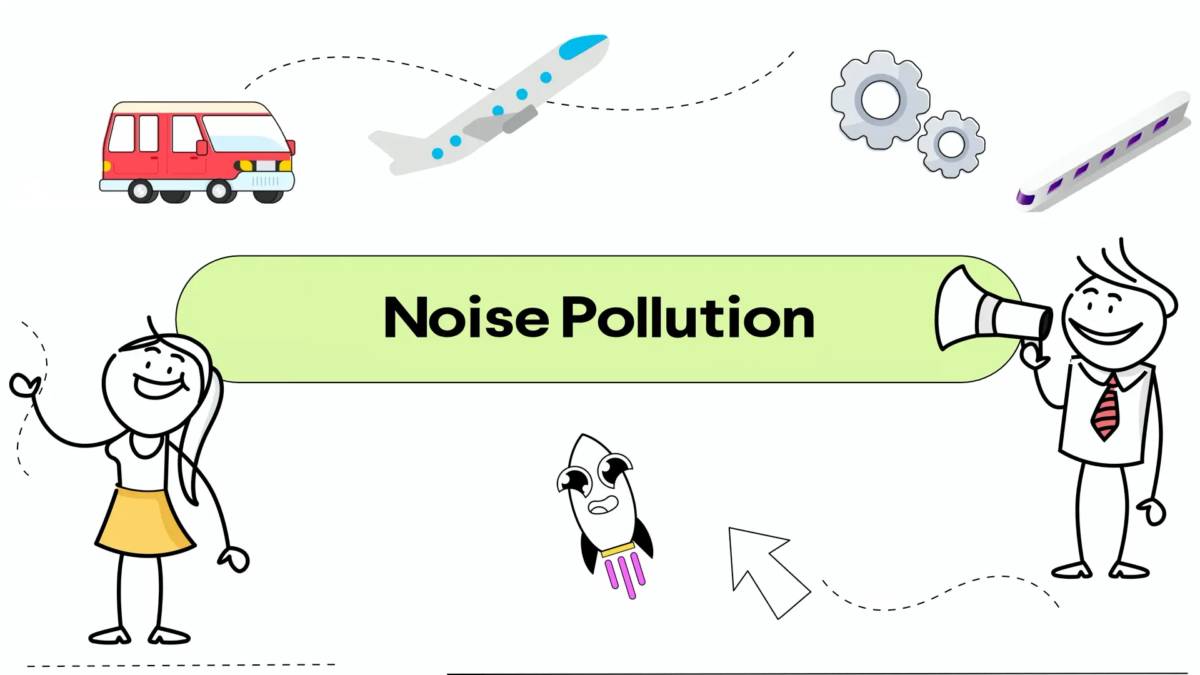Unlike other visible forms of pollution such as water, land, and air pollution, noise pollution cannot be seen, but it can still be detrimental to those exposed. In this article, we will be discussing what noise is, the sources of noise, how we can measure it, and the effects of noise pollution at various levels.
The 20th Century: “Century Of Noise”
The 20th century is often referred to as the “century of noise” because it saw a dramatic increase in the amount of noise pollution in the environment due to technological advancements and changes in social norms.
During this century, there was a rapid increase in industrialization, urbanization, and the use of motorized vehicles, all of which contributed to an increase in noise levels. The development of new technologies, such as airplanes, automobiles, and home appliances, also added to noise pollution.
In addition, the rise of mass media and entertainment, such as radio, television, and concerts, contributed to a more noise-filled environment. The widespread use of headphones and personal music devices also meant that individuals could create their own personal soundscapes, further adding to the overall noise level.

What is Noise?
As we are aware, sound is everywhere – from the alarm clock that wakes us up in the morning, to the sound of the school bus, road traffic, loudspeakers, and so on. These sounds are an integral part of our daily routine, and we are fortunate to be able to hear everything around us.
However, at times, these necessary sounds can become dangerously loud, and if they persist for too long, they can lead to noise pollution, which is harmful to all living beings.
Sources of Noise
Sources of noise can be seen as natural or man-made but the latter become increasingly important as we face it more frequently.
Automobiles, factories, industries, air-crafts, etc are a few examples. Noise levels are particularly acute near railway junctions, traffic roundabouts, bus terminuses, and airports. The use of pressure horns, and recreational noise of loudspeakers at full volume during festivities particularly at night are other sources of noise production. The domestic noises from the radios, transistors, T.V sets – all add to the quantum of noise in daily life.
Property of Sound
Sound has two important properties loudness or intensity, and frequency.
The loudness of the Noise
The loudness of noise is measured in decibels (dB).
Although Recommended maximum loudness is 85 db, we come across as low as 20 db sound produced by whisper to 160 db intense sound which can cause mechanical damage to the eardrum.

As humans respond non-uniform way to different sounds, noise levels are expressed in dbA, where A is for the subjective effects of sound.

A few recommended levels are 20-35 dbA in hospital wards, 40-60 dbA in the industrial workshop, and 25 dbA in our bedroom.
Frequency of Sound

The frequency is denoted as Hertz(Hz.) One Hz is equal to one wave per second. The human can hear frequencies from about 20 to 20,000 Hz, but this range is reduced with age and other subjective factors.
The range of vibrations below 20 Hz is infra-audible, and those above 20,000 Hz are ultra-sonic.
Many animals (e.g., dogs) can hear sounds inaudible to the human ear. The Phon is a psycho-acoustic index of loudness. It takes into consideration intensity and frequency
Instruments Used To Study Noise
The basic instruments used in studies on noise are
(1) the “Sound Level Meter” which measures the intensity of sound in dB or dB (A)

(2) the “Octave Band Frequency Analyzer,” which measures the noise in octave bands. The resulting plot shows the “sound spectrum” and indicates the characteristics of the noise, whether it is mainly high-pitched, low-pitched, or of variable pitch, and

(3) the “Audiometer” which measures hearing ability. The zero line at the top of the audiogram represents normal hearing. Noise-induced hearing loss shows a characteristic dip in the curve at the 4000 Hz frequency.

Let us now talk about the effects of exposure to loud noise!
The Harmful Effects of Noise Pollution on Our Health
There are two types of effects caused by noise exposure: auditory and non-auditory.
The auditory effects of Noise
The auditory effects can be further categorized into two types.
Firstly, auditory fatigue is most prominent at around 90 dB and reaches its peak at 4000 Hz. This may result in side effects such as buzzing or whistling in the ears.
Secondly, deafness or hearing loss is the most serious pathological effect. Initially, the victim may not be aware of it. Temporary hearing loss occurs due to a specific exposure to noise, usually in the frequency range of 4000 to 6000 Hz. The disability disappears after a period of up to 24 hours following the noise exposure. However, repeated or continuous exposure to noise of around 100 decibels may lead to permanent hearing loss. In such cases, damage to the inner ear can vary from minor changes in the hair cell endings to complete destruction of the organs of Corti.

Occupational hearing loss occurs when this happens due to exposure to noise in industries. Exposure to noise above 160 dB can result in the rupture of the tympanic membrane and cause permanent hearing loss.
The Non-Auditory Effects of Noise
The non-auditory effects of noise exposure can be divided into several categories.
Firstly, noise can interfere with speech communication. Frequencies between 300-500 Hz, commonly present in road and air traffic noise, are particularly disruptive. For good speech intelligibility, the speech sound level must exceed the SIL (Speech Interference Level) by approximately 12 dB.
Secondly, noise can cause annoyance, which is primarily a psychological response. Neurotic people are more sensitive to noise than balanced individuals. Workmen exposed to high levels of noise in occupational capacities are often irritable, short-tempered, and impatient, and may resort to agitation and disrupt production.
Thirdly, noise can affect mental concentration, and a low level of noise is always desired where mental concentration is required. Reduction in noise has been found to increase work output.
Fourthly, noise exposure can cause temporary physiological changes in the human body, such as a rise in blood pressure, intracranial pressure, heart rate, breathing, and sweating. General symptoms such as giddiness, nausea, and fatigue may also occur. Noise interferes with sleep and may cause visual disturbance, such as a narrowing of pupils, affect color perception, and reduce night vision.
Lastly, besides affecting health, noise is also a significant factor in economic losses. The potential cost of noise-induced hearing loss to the industry is considerable.
Which Are The Steps That Can Be Taken To Control Noise?
Controlling noise requires a variety of strategies.
- Cities should be planned carefully, with zoning to separate residential areas from noisy industries and transport, and green belts to provide a buffer.
- Vehicles should be controlled, with heavy vehicles avoiding narrow streets and restrictions on horn use.
- Building design should include acoustic insulation, with noise-producing installations prohibited.
- Industrial areas and railways should be located outside residential areas or separated by protective green belts.
- Hearing protection is recommended for workers exposed to loud noise, and legislation has been enacted to provide compensation for hearing loss.
- Education of the public is also necessary to raise awareness of the hazards of noise.
- Noise regulation: Governments can regulate noise levels in various settings, such as industrial areas, construction sites, and public transportation. The World Health Organization (WHO) has established noise guidelines for different environments, which governments can use to set noise limits and enforce them.
- Personal protective measures: Wearing earplugs or noise-canceling headphones can help reduce exposure to noise pollution, especially for people who live or work in noisy areas.
- Research: Scientific studies should be undertaken to back strategies for reducing noise pollution:
Lastly, Can Noise Affect Doctors?
Yes, noise pollution can affect doctors and other healthcare professionals, especially those who work in hospitals or clinics. Healthcare settings are often noisy environments, with a variety of sounds such as alarms, beeps, intercom announcements, conversations, and equipment noise, among others.
Excessive and prolonged exposure to noise pollution in healthcare settings can lead to several negative effects on doctors and healthcare workers.
For example:
Communication difficulties: Noise pollution can interfere with effective communication, leading to misunderstandings, errors, and misinterpretations.
Stress and fatigue: Exposure to constant and loud noise pollution can lead to increased levels of stress and fatigue, which can affect job performance and well-being.
Reduced patient satisfaction:
Medical errors: Studies have shown that noise pollution in healthcare settings can increase the likelihood of medical errors, such as medication errors, misdiagnosis, and delayed treatment.
“In a few years’ time the needless noise-maker will be an outlaw from sober and intelligent society: a rude uncouth creature who will find it to his interest to mend his ways. We may predict that in a few years’ time the delicate fabric of our bodies and minds will no longer be menaced and mutilated by the brutality of unnecessary noise”
-Anti-Noise League, 1935
FAQs On Noise
How loud is too loud?
The WHO guidelines for community noise recommend less than 30 A-weighted decibels (dB(A)) in bedrooms during the night for a sleep of good quality and less than 35 dB(A) in classrooms to allow good teaching and learning conditions.
The WHO guidelines for night noise recommend less than 40 dB(A) of annual average (Lnight) outside of bedrooms to prevent adverse health effects from night noise.
How is noise measured?
Noise is typically measured in decibels (dB), which is a logarithmic scale that expresses the intensity of a sound relative to a reference level. A-weighting is often used to account for the frequency sensitivity of the human ear.
How can noise be reduced?
There are various methods to reduce noise, including using noise-canceling headphones or earplugs, adding soundproofing materials, using low-noise electronic components, and employing noise-reducing techniques in signal processing.
What is noise pollution?
Noise pollution refers to the excessive or unwanted levels of sound that can have harmful effects on human health and the environment.
What are the sources of noise pollution?
Some common sources of noise pollution include transportation, industrial activity, construction work, household appliances, and recreational activities.
What are the effects of noise on human health?
Exposure to high levels of noise can cause a variety of health effects, including hearing loss, tinnitus, stress, sleep disturbance, and cardiovascular disease.
What are the effects of noise pollution on the environment?
Noise pollution can have adverse effects on wildlife, causing changes in behavior, decreased reproductive success, and even death.
How can noise pollution be reduced?
There are various methods to reduce noise pollution, including using noise barriers and soundproofing materials, designing buildings and infrastructure to reduce noise transmission, and limiting noise levels through regulations and enforcement.
What is the role of technology in reducing noise pollution?
Technology can play an important role in reducing noise pollution, through the development of quieter machinery and transportation, and the use of noise-canceling technologies in headphones and other devices.
What is community noise mapping?
Community noise mapping involves the use of sound level measurements and computer modeling to create maps of noise levels in a given area. This information can be used to identify areas with high noise levels and to develop noise mitigation strategies.
What is occupational noise exposure?
Occupational noise exposure refers to the levels of noise that workers are exposed to on the job. Employers are required to provide hearing protection and other measures to reduce occupational noise exposure.
What can individuals do to reduce noise pollution?
Individuals can take steps to reduce their own noise pollution, such as using quieter appliances, limiting the use of loud machinery and recreational activities, and wearing ear protection in loud environments.
Quiz On Noise
Test your knowledge of Noise and noise pollution.
#noisePollution #health #environment #hearingLoss #sleepDisturbance #cardiovascularDisease #wildlife #ecosystems #quiet #healthylifestyle #actionableSteps #awareness #sustainability #greenliving #savetheplanet #globalissue #publichealth #nature #urbanliving #citynoise

Add a Comment
You must be logged in to post a comment